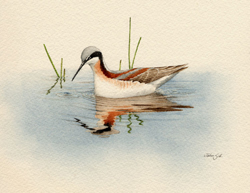Breeding Bird Atlases (BBA)
Find a Bird - BBA1
Breeding Bird Atlas 1 Species Accounts
Wilson's Phalarope
Phalaropus tricolor
Egg Dates
June
Number of Broods
one

The main breeding grounds of the Wilson’s Phalarope are the shallow, cattail-rimmed sloughs, marshy farm ponds, and wet grassy meadows of the western plains states and occidental provinces of Canada. There, in prairie pothole country, the ornately plumaged Wilson’s Phalarope shares its home with the vast majority of the continent’s breeding “puddle ducks.”
The coast of Massachusetts is a long way from the prairies, but the pioneering Wilson’s Phalarope, the landlubber of the phalarope trio and the only species limited to the New World, has worked its way eastward in recent years, extending its limits and establishing outposts disjunct from its normal range. By 1978, seven pairs were recorded in Quebec about 50 miles northeast of Montreal, and in previous seasons there had been suspected nesting in New Brunswick, upstate New York, and Virginia. The discovery of a pair and nest with three eggs at Plum Island on June 29,1979, provided the first breeding record for Massachusetts and the East Coast. An unusual aspect at this site was the phalaropes’ choice of nesting habitat: a Salt-hay marsh instead of the typical freshwater slough or impoundment. The summer after the Atlas period, a male Wilson’s Phalarope was flushed from a nest also containing three eggs in the Monomoy Island marsh on June 7 (Petersen). These two occurrences remain the only “confirmed” evidence of breeding activity in the region, although the continued presence of multiple pairs at Plum Island each summer strongly suggests that they are now nesting regularly there.
Wilson’s Phalaropes arrive in spring during May and are seen at coastal locations throughout the summer, particularly at the known breeding sites. An interesting aspect of the breeding biology of all three species of phalaropes is a complete sex-role reversal. The larger, brighter female performs the displays, attracts a mate, and then leaves the rather drably attired male to incubate the eggs and begin tending the young. Both Massachusetts nests consisted of a grass-lined depression well concealed in saltwater grasses. Each contained three eggs, at least at the time of their discoveries, rather than the usual four typical of most shorebirds. Excessive high tides pose a very real danger to salt marsh nests, and the ultimate success of both nests was not known. After a 20- to 21-day incubation period, the precocial, downy young hatch and are soon led away from the nest to avoid detection by predators. Typically, a number of pairs nest in close proximity, forming a loose colony.
If one enters a territory, the male phalarope will fly up out of the marsh, seemingly appearing from nowhere. He soon initiates a low, circling flight overhead and utters a distinctive, soft, nasal honking reminiscent of that of a disturbed Red-breasted Nuthatch. If one strays too close to the nest or young, a series of shallow dive-bombings and vocalizations at an increased pitch will usually ensue.
By late summer, the young are fully fledged and have acquired the sleek dress of juvenal plumage. In that season, they appear with the adults along the muddy edges of rain pools, where they dart about after insects or spin buoyantly on the surface of a shallow slough, picking items from the surface. In Massachusetts they are attracted to both salt pannes and muddy tidal flats. From July through September, the small Massachusetts population is usually supplemented by migrants from farther west. These migrant birds typically occur on the coastal plain, seeking out salt marsh pools, shallow farm ponds, and the muddy perimeters of drawn-down reservoirs. Adults generally depart before birds of the year, and the later sightings are invariably of juveniles, most likely migrants from other regions. The Wilson’s Phalarope is an impressive long-distance traveler, wintering chiefly in Argentina and Chile.
Map Legend and Data Summary
Atlas 1 data collected from 1975-1979


Note: rare in coastal marshes at Parker River National Wildlife Refuge; once at Monomoy National Wildlife Refuge (1980)
Richard S. Heil



